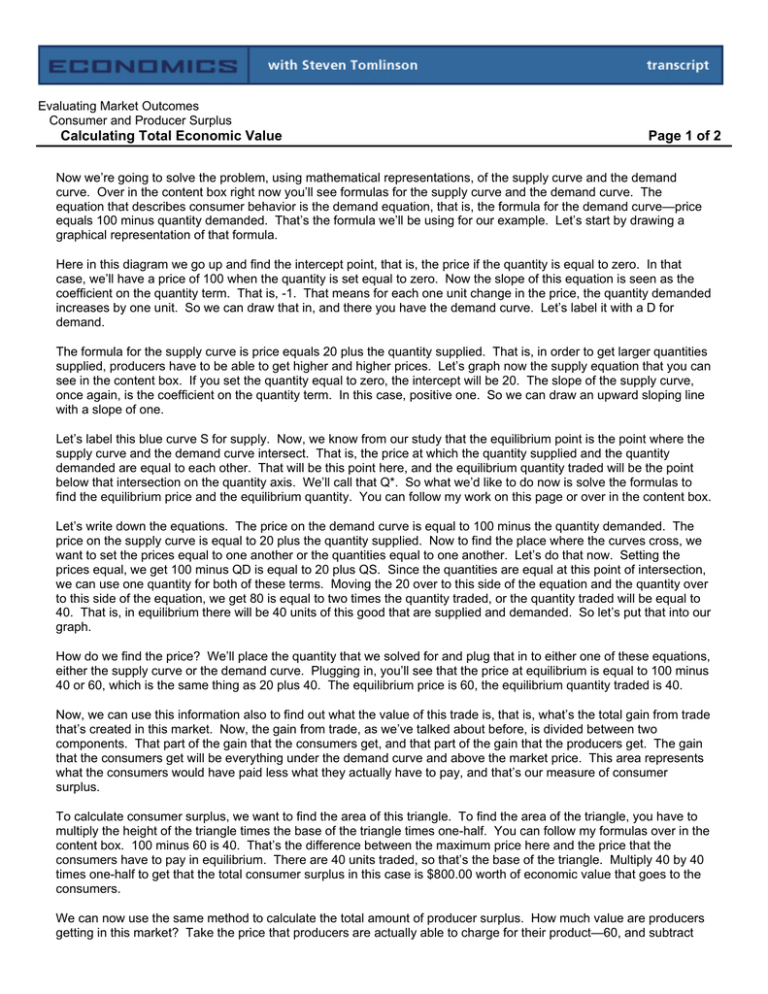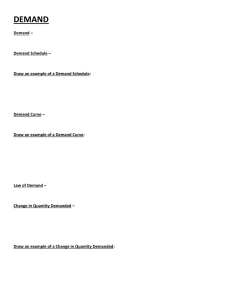Calculating Total Economic Value Page 1 of 2
advertisement

Evaluating Market Outcomes Consumer and Producer Surplus Calculating Total Economic Value Page 1 of 2 Now we’re going to solve the problem, using mathematical representations, of the supply curve and the demand curve. Over in the content box right now you’ll see formulas for the supply curve and the demand curve. The equation that describes consumer behavior is the demand equation, that is, the formula for the demand curve—price equals 100 minus quantity demanded. That’s the formula we’ll be using for our example. Let’s start by drawing a graphical representation of that formula. Here in this diagram we go up and find the intercept point, that is, the price if the quantity is equal to zero. In that case, we’ll have a price of 100 when the quantity is set equal to zero. Now the slope of this equation is seen as the coefficient on the quantity term. That is, -1. That means for each one unit change in the price, the quantity demanded increases by one unit. So we can draw that in, and there you have the demand curve. Let’s label it with a D for demand. The formula for the supply curve is price equals 20 plus the quantity supplied. That is, in order to get larger quantities supplied, producers have to be able to get higher and higher prices. Let’s graph now the supply equation that you can see in the content box. If you set the quantity equal to zero, the intercept will be 20. The slope of the supply curve, once again, is the coefficient on the quantity term. In this case, positive one. So we can draw an upward sloping line with a slope of one. Let’s label this blue curve S for supply. Now, we know from our study that the equilibrium point is the point where the supply curve and the demand curve intersect. That is, the price at which the quantity supplied and the quantity demanded are equal to each other. That will be this point here, and the equilibrium quantity traded will be the point below that intersection on the quantity axis. We’ll call that Q*. So what we’d like to do now is solve the formulas to find the equilibrium price and the equilibrium quantity. You can follow my work on this page or over in the content box. Let’s write down the equations. The price on the demand curve is equal to 100 minus the quantity demanded. The price on the supply curve is equal to 20 plus the quantity supplied. Now to find the place where the curves cross, we want to set the prices equal to one another or the quantities equal to one another. Let’s do that now. Setting the prices equal, we get 100 minus QD is equal to 20 plus QS. Since the quantities are equal at this point of intersection, we can use one quantity for both of these terms. Moving the 20 over to this side of the equation and the quantity over to this side of the equation, we get 80 is equal to two times the quantity traded, or the quantity traded will be equal to 40. That is, in equilibrium there will be 40 units of this good that are supplied and demanded. So let’s put that into our graph. How do we find the price? We’ll place the quantity that we solved for and plug that in to either one of these equations, either the supply curve or the demand curve. Plugging in, you’ll see that the price at equilibrium is equal to 100 minus 40 or 60, which is the same thing as 20 plus 40. The equilibrium price is 60, the equilibrium quantity traded is 40. Now, we can use this information also to find out what the value of this trade is, that is, what’s the total gain from trade that’s created in this market. Now, the gain from trade, as we’ve talked about before, is divided between two components. That part of the gain that the consumers get, and that part of the gain that the producers get. The gain that the consumers get will be everything under the demand curve and above the market price. This area represents what the consumers would have paid less what they actually have to pay, and that’s our measure of consumer surplus. To calculate consumer surplus, we want to find the area of this triangle. To find the area of the triangle, you have to multiply the height of the triangle times the base of the triangle times one-half. You can follow my formulas over in the content box. 100 minus 60 is 40. That’s the difference between the maximum price here and the price that the consumers have to pay in equilibrium. There are 40 units traded, so that’s the base of the triangle. Multiply 40 by 40 times one-half to get that the total consumer surplus in this case is $800.00 worth of economic value that goes to the consumers. We can now use the same method to calculate the total amount of producer surplus. How much value are producers getting in this market? Take the price that producers are actually able to charge for their product—60, and subtract Evaluating Market Outcomes Consumer and Producer Surplus Calculating Total Economic Value Page 2 of 2 the cost that the producers incur when they make the product. That’s represented by the height of the blue line. The producer surplus then will be the area of this triangle—60 minus 20 times 40 times one-half. In this case, producer surplus is also equal to $800.00 worth of economic value. Add the two together—consumer surplus plus producer surplus to get a total of $1600.00 worth of economic value. That’s the total surplus, or total economic value created in this market.







